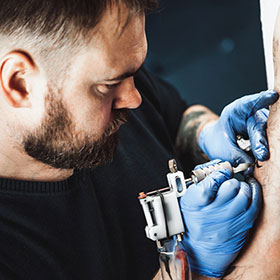Yes, hand tattoos can hurt. The pain varies for each person.
Tattoos on the hand tend to be more painful due to the thin skin and lack of muscle. The hands have many nerve endings, which can make the process uncomfortable. While some people describe the pain as a sharp sensation, others feel a more intense, burning pain.
The level of discomfort also depends on the design and duration of the tattoo session. Despite the pain, many people choose to get hand tattoos for their unique and visible placement. Understanding what to expect can help you prepare better. So, let’s explore why hand tattoos hurt and what you can do to manage the pain.
Introduction To Hand Tattoos
Hand tattoos are becoming more popular. Celebrities and influencers love them. Many people choose small, simple designs. Others prefer bold, detailed art. Hand tattoos are easy to show off. They are also hard to hide. This makes them a big commitment. The trend keeps growing every year. More tattoo artists now specialize in hand tattoos.
Hand tattoos have deep cultural meanings. Some cultures use them for rituals. Others see them as symbols of strength. In some places, only certain people can have them. This shows their high status. Tattoos can also tell stories. They can honor family or represent beliefs. Each design carries its own unique meaning.
Anatomy Of The Hand
The hand has many small bones. These bones are close to the skin. Getting a tattoo on the hand can hurt because of this. The bones in the hand are called metacarpals and phalanges.
Hand tattoos can be painful. The needle comes close to the bones. This can make the pain sharper. Some areas of the hand may hurt more than others.
The hand has many nerve endings. These nerves make the skin very sensitive. Tattoos on the hand can feel very painful. The nerves react to the tattoo needle. This makes the pain intense.
Different people have different pain levels. Some may feel more pain. Others may feel less. The nerves in the hand are one reason for the pain.
Factors Influencing Pain Levels
Everyone feels pain differently. Some people have high pain tolerance. Others feel pain more easily. This difference affects how much a tattoo hurts. Pain also depends on the person’s mood and stress levels. Relaxation can help reduce pain. Staying calm is important.
Small tattoos often hurt less. Large tattoos cover more skin. So, they may cause more pain. Detailed designs require more work. This can increase the pain. Simple designs may be quicker and less painful. The time spent on the tattoo also matters. Longer sessions can cause more discomfort.
Common Pain Points On The Hand
Hand tattoos can hurt a lot. The knuckles and fingers are very sensitive. This is due to the thin skin and many nerves. Pain can vary from person to person. Some feel a sharp pain while others feel a dull ache. Small tattoos might hurt less. Larger tattoos can be more painful. The healing process can also be uncomfortable. Swelling is common. Fingers may feel stiff after the tattoo.
The palm and wrist can hurt too. The palm has many nerves. Tattoos here can cause a burning sensation. The wrist is also sensitive. The bones are close to the skin. This can make the pain sharper. Pain levels can differ. Some people find the wrist less painful. Others find it very painful. The skin on the wrist can be tender. This can make healing slower. Extra care is needed for these areas.
Pain Management Techniques
Topical anesthetics can reduce pain during hand tattoos. They are applied to the skin. These creams numb the area. This makes the tattoo process less painful. You can buy them over the counter. Or you can ask your tattoo artist for recommendations. Always test a small area first. This ensures you don’t have an allergic reaction.
Breathing exercises help manage pain during tattoos. Deep breaths calm your body. This reduces tension and pain. Inhale slowly through your nose. Hold your breath for a few seconds. Exhale slowly through your mouth. Repeat this to stay calm. This technique is easy and effective.
Aftercare For Hand Tattoos
Hand tattoos need proper care to heal well. Moisturizing is key. Use a fragrance-free lotion. Apply it gently. Do not rub too hard. Keep the tattoo hydrated. Dry tattoos can crack and hurt. Moisturize twice a day. Morning and night.
Keeping your hand tattoo clean is crucial. Wash your hands with mild soap. Do this twice a day. Avoid touching the tattoo with dirty hands. Do not scratch the tattoo. It can cause infections. Cover the tattoo if you are in a dirty place. Change the cover regularly. Watch for signs of infection. Redness, swelling, or pus are bad signs. Seek help if these occur.
Real Stories From Tattoo Enthusiasts
Many say hand tattoos can be quite painful. The skin on the hands is thin. This makes the tattooing process feel intense. Some describe it as a sharp, burning pain. Others say it feels like a constant scratch. Pain levels can vary from person to person.
Consider starting with a small design. This can help you understand the pain. Try to stay relaxed during the process. Deep breaths can help. Talk to your tattoo artist about your concerns. They can offer tips to manage pain. Aftercare is also important. Keep the tattoo clean and moisturized. This helps with healing and reduces discomfort.
Conclusion
Hand tattoos can be painful for many people. The skin on the hand is thin. There are many nerves. This makes the area sensitive. Pain levels vary for each person. Some may find it more tolerable. Others might experience more discomfort.
Proper aftercare can help manage the pain. Consider your pain threshold before deciding. Consult with a professional tattoo artist. They can offer guidance and advice. Hand tattoos can be a bold choice. Make sure you are prepared for the experience.

